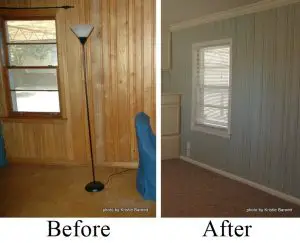Table of Contents
Introduction
Properly maintained and well painted wood paneling always looks good, but old houses usually have flaky paneling due to poor maintenance. If you are considering giving the wood paneling in your home a “facelift,” then you would want to paint it to give it that new look. It can be hard to paint wooden paneling, especially if it has apparent knots on it.
The knots can be hard to clean and cover appropriately with paint, and the steps involved in preparing wood paneling before painting can seem daunting. But not to worry, we have compiled a list of the step by step process of painting paneling; it should help simplify the intimidating task of painting paneling. If you follow the guide properly, you should get a smooth finish.
Also, check;
Preparation Of The Wooden Paneling For Painting
Some of the tools you will need to prepare and paint the wood paneling are toxic and hazardous. So ensure that you start by equipping yourself with your full safety gear and also the work area before you begin painting. Areas that you want to be kept clean should be covered with old sheets and taped in place to prevent the sheets from slipping while you’re painting. Also, make sure that all the windows are open to allow the room to be properly ventilated.
It is highly important that you wear your safety gear such as goggles, long sleeve clothing, gloves, and respiratory mask at all times while painting. The first step to take is wiping down the wood paneling with a diluted solution of TSP (trisodium phosphate) to get rid of the oils and dirt. Handle this cleaner with care because it is toxic and dangerous.
After you have thoroughly cleaned the paneling, you can start sanding down the wood paneling. Make use of a 200 grit fine sandpaper and sand in circular motions to make a lightly textured surface that will allow the primer to stick properly. After sanding the paneling, wipe it down with a damp cloth to get rid of any dust the sanding may have caused; you can vacuum the dust carefully.
Apply Primer To The Wooden Paneling
Paint easily sticks to wood, but applying primer is still an important step when painting wood paneling. Adding a coat of paint primer allows the paint to adhere more effectively than on bare wood, and it also gives the surface of the paneling a smooth and neat looking finish after painting. Using paint to cover the wood grain and imperfections will make a lot of difference in the way your paneling looks.
In order to get the best finish when you are done painting, it is essential to use the best primer for painting wood. If solid wood was used in making your wood paneling, then use a water-based primer but if your paneling is coated with veneer, make use of a shellac-based primer. Other than these reasons, the primer you should use should be based on preference.
However, you should also know about the existence of stain blocking primer. This primer provides you with solid-color coverage and its ability to hide irregularities in the color where the knots and other features are present. Apply the primer in two even coats and make sure it gets into the corners of the paneling.
You can easily use a roller to paint primer unto the wood paneling. It will also work well in getting paint into the gaps in the panels. But you will need a small brush to paint the corners and crevices of the paneling, but you can use a roller for the rest of the paneling. The time needed by the primer to properly dry varies between types but leave it for an hour to two hours between coats to dry. However, go the aneling overnight between priming and painting.
Paint Wood Paneling
Preparing the wooden paneling for painting is harder than painting the paneling. Use the same tools to apply thin and even coats using a roller and use a smaller brush for the crevices. Wipe away any excess paint that may pool in the gaps between the panels; if left to pool, it will dry in a tacky manner.
Apply two to three thin coats to achieve the full coverage you want; lightly sand between the coats. Ensure that you sand lightly; if not, you will sand away the new paint and ensure that you allow it dry for a sufficient amount of time between coats. If you feel the three coats aren’t enough, you could apply a fourth coat. But that is very unlikely, two coats are usually sufficient, and a third coat should cover any imperfections left.
Paint the trim with whatever color you desire. But it is best to use a glossy finish on the trims, but it all depends on your preference. Glossy paint makes the trim stand out, and it also gives the surface a smooth finish that is easy to clean.
After the final coat has dried overnight, you are done painting. Arrange and pack your safety sheets, and you will be able to use the room again, but with fresh and clean looking wooden paneling.
Conclusion
Painting the wooden paneling in your house doesn’t need to be a daunting task. It takes time and care, but you will achieve the results you want if you put in time and effort into properly completing the project. A room’s feel can be drastically changed with just a fresh and clean coat of paint; it will look brighter and better than old wood paneling with old paint.
If you follow the above steps, you shouldn’t find painting paneling an intimidating and challenging task. To get a high-quality result, you need to put in the effort, but you can manage it on your own, and the steps should help simplify the process a bit and make it easier to comprehend.

